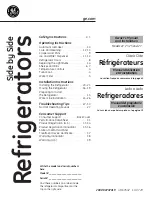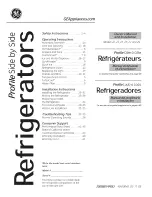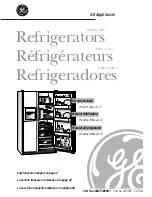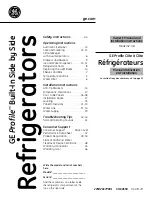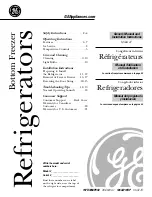
49-1000502 Rev. 0
3
CAUTION
To reduce the risk of injury when using your refrigerator, follow these basic safety precautions .
■ Do not clean glass shelves or covers with warm
water when they are cold . Glass shelves and
covers may break if exposed to sudden temperature
changes or impact, such as bumping or dropping .
Tempered glass is designed to shatter into many
small pieces if it breaks .
■ Keep fingers out of the “pinch point” areas;
clearances between the doors and between the
doors and cabinet are necessarily small . Be careful
closing doors when children are in the area .
■ Do not touch the cold surfaces in the freezer
compartment when hands are damp or wet, skin
may stick to these extremely cold surfaces .
■ Do not refreeze frozen foods which have thawed
completely .
■ In refrigerators with automatic ice makers, avoid
contact with the moving parts of the ejector
mechanism, or with the heating element that
releases the cubes . Do not place fingers or hands
on the automatic ice making mechanism while the
refrigerator is plugged in .
SAFETY
INFORMA
TION
READ AND SAVE THESE INSTRUCTIONS
WARNING
To reduce the risk of fire, explosion, electric shock, or injury when using your refrigerator, follow
these basic safety precautions:
■ This refrigerator must be properly installed
and located in accordance with the Installation
Instructions before it is used .
■ Unplug the refrigerator before making repairs or
cleaning .
NOTE:
Power to the refrigerator cannot be
disconnected by any setting on the control panel .
NOTE:
Repairs must be performed by a qualified
Service Professional .
■ Replace all parts and panels before operating.
■ Do not use an extension cord.
■ Keep flammable materials and vapors away from the
refrigerator .
■ Do not store explosive substances such as aerosol
cans with a flammable propellant in this appliance .
■ To prevent suffocation and entrapment hazards
to children, remove the fresh food and freezer
doors from any refrigerator before disposing of it or
discontinuing its use .
■ To avoid serious injury or death, children should not
stand on, or play in or with the appliance .
■ Children and persons with reduced physical, sensory
or mental capabilities or lack of experience and
knowledge can use this appliance only if they are
supervised or have been given instructions on safe
use and understand the hazards involved .
■ This appliance is intended to be used in household
and similar applications such as: staff kitchen areas
in shops, offices and other working environments;
farm houses; by clients in hotels, motels, bed
& breakfast and other residential environments;
catering and similar non-retail applications .
■ Connect to potable water supply only. A cold water
supply is required for automatic icemaker operation .
The water pressure must be between 40 and 120 psi
(275-827 kilopascals) .
■ Do not apply harsh cleaners to the refrigerator.
Certain cleaners will damage plastic which may
cause parts such as the door or door handles to
detach unexpectedly . See the Care and Cleaning
section for detailed instructions .
IMPORTANT SAFETY INFORMATION
READ ALL INSTRUCTIONS BEFORE USING THE APPLIANCE
WARNING
FIRE OR EXPLOSION HAZARD Flammable Refrigerant
This appliance contains isobutane refrigerant, also known as R600a, a natural gas with high environmental
compatibility. However, it is also combustible. Adhere to the warnings below to reduce the risk of injury
or property damage.
1.
When handling, installing and operating the
appliance, care should be taken to avoid damage to
the refrigerant tubing .
2.
Service shall only be performed by authorized
service personnel . Use only manufacturer-authorized
service parts .
3.
Dispose of refrigerator in accordance with the
Federal and Local Regulations . The flammable
refrigerant and insulation material used in this
product require special disposal procedures . Contact
your local authorities for the environmentally safe
disposal of your refrigerator .
4.
Keep ventilation openings in the appliance
enclosures or in the built-in structure clear of
obstruction .
5.
To remove frost, scrape with a plastic or wood spatula
or scraper . Do not use an ice pick or a metal or
sharp-edged instrument as it may puncture the freezer
liner and then the flammable refrigerant tubing behind it .
6.
Do not use electrical appliances inside the food
storage compartment of the appliance .
7.
Do not use any electrical device to defrost your
freezer .



















